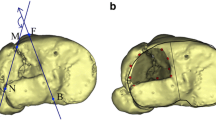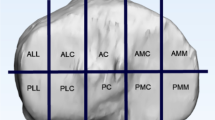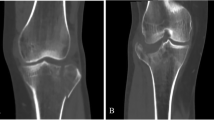Abstract
Purpose
This study was aimed at analyzing the incidence and characteristics of hyperextension tibial plateau fractures (HTPFs) by using a computed tomography (CT)–based “four-column and nine-segment” classification.
Methods
In the coronal plane, HTPFs are divided into four types: pure hyperextension, hyperextension–varus, hyperextension–valgus, and hyperextension–bicondylar. Fractures in the sagittal plane were divided into three types: type 1, pure depression; type 2, cleavage extending to the posterior cortex with no displacement; and type 3, cleavage extending to the posterior cortex with a significant displacement. A retrospective analysis of CT images of the tibial plateau fractures from December 2007 to December 2021 was conducted. Fracture mapping was analyzed and drawn using the new classification system.
Results
A total of 136 (10.9%, 136/1253) fractures fulfilled the radiographic criteria for HTPF pattern in 136 knees (53.5 ± 13.3 years). There were 11 knees with pure hyperextension fracture (8.1%), 23 with hyperextension–varus fracture (16.9%), 46 with hyperextension–valgus fracture (33.8%), and 56 with hyperextension–bicondylar fracture (41.2%) in the coronal plane. Furthermore, there were 64 (47.1%), 47 (34.6%), and 25 (18.4%) cases of type 1, type 2, and type 3 fractures, respectively, in the sagittal plane. In the three-dimensional heat map, the fracture lines were mainly located at the anterior rim of the tibial plateau, while the posterior articular surface was rarely involved.
Conclusions
The main manifestations of HTPF are anterior compression and posterior avulsion injury. The CT-based four-column and nine-segment classification system could be used to categorize the injury characteristics of HTPF in the coronal and sagittal planes.








Similar content being viewed by others
References
Nagel DA, Burton DS, Manning J (1977) The dashboard knee injury. Clin Orthop Relat Res(126):203–8
Tomas-Hernandez J, Monyart JM, Serra JT, Vinaixa MR, Farfan EG, Garcia VM et al (2016) Large fracture of the anteromedial tibial plateau with isolated posterolateral knee corner injury: case series of an often missed unusual injury pattern. Injury-Int J Care of the Injured 47:S35–S40. https://doi.org/10.1016/S0020-1383(16)30604-0
Wu K, Huang J, Lin J, Wang Q (2017) Diagnosis and treatment of anterior tibial plateau fracture-dislocation: a case series and literature review. J Knee Surg 30(2):114–20. https://doi.org/10.1055/s-0036-1581136
Chouhan DK, Chand Saini U, Kumar Rajnish R, Prakash M (2020) Complex bicondylar tibial plateau fractures with reversed tibial slope - our experience with a fracture-specific correction strategy. Trauma Case Rep 25:100256. https://doi.org/10.1016/j.tcr.2019.100256
Firoozabadi R, Schneidkraut J, Beingessner D, Dunbar R, Barei D (2016) Hyperextension varus bicondylar tibial plateau fracture pattern: diagnosis and treatment strategies. J Orthop Trauma 30(5):e152-7. https://doi.org/10.1097/BOT.0000000000000510
Gonzalez LJ, Lott A, Konda S, Egol KA (2017) The hyperextension tibial plateau fracture pattern: a predictor of poor outcome. J Orthop Trauma 31(11):e369–e74. https://doi.org/10.1097/BOT.0000000000000930
Conesa X, Minguell J, Cortina J, Castellet E, Carrera L, Nardi J et al (2013) Fracture of the anteromedial tibial plateau associated with posterolateral complex injury: case study and literature review. J Knee Surg 26(Suppl 1):S34-9. https://doi.org/10.1055/s-0031-1280969
Bu G, Sun W, Lu Y, Cui M, Zhang X, Lu J et al (2021) Complications associated with hyperextension bicondylar tibial plateau fractures: a retrospective study. BMC surgery 21(1):299. https://doi.org/10.1186/s12893-021-01215-1
Schatzker J (1974) Compression in the surgical treatment of fractures of the tibia. Clin Ortho Relat Res(105):220–39
Marsh JL, Slongo TF, Agel J, Broderick JS, Creevey W, DeCoster TA et al (2007) Fracture and dislocation classification compendium - 2007: Orthopaedic Trauma Association Classification, Database and Outcomes Committee. J Orthop Trauma 21(10 Suppl):S1-133. https://doi.org/10.1097/00005131-200711101-00001
Meinberg EG, Agel J, Roberts CS, Karam MD, Kellam JF (2018) Fracture and Dislocation Classification Compendium-2018. J Orthop Trauma 32(Suppl 1):S1–S170. https://doi.org/10.1097/BOT.0000000000001063
Luo CF, Sun H, Zhang B, Zeng BF (2010) Three-column fixation for complex tibial plateau fractures. J Orthop Trauma 24(11):683–92. https://doi.org/10.1097/BOT.0b013e3181d436f3
Sheehan SE, Khurana B, Gaviola G, Davis KW (2014) A biomechanical approach to interpreting magnetic resonance imaging of knee injuries. Magn Reson Imaging Clin N Am 22(4):621–48. https://doi.org/10.1016/j.mric.2014.07.006
Zhang X, Tian X, Wang S, Hu Y, Pan S, Peng A (2021) Different patterns of tibial plateau fractures associated with hyperextension injuries of the knee with or without varus/valgus component. Med 100(51):e28337. https://doi.org/10.1097/md.0000000000028337
Yao X, Xu Y, Yuan J, Lv B, Fu X, Wang L et al (2018) Classification of tibia plateau fracture according to the “four-column and nine-segment.” Injury 49(12):2275–83. https://doi.org/10.1016/j.injury.2018.09.031
Yao X, Zhou K, Lv B, Wang L, Xie J, Fu X et al (2020) 3D mapping and classification of tibial plateau fractures. Bone Joint Res 9(6):258–67. https://doi.org/10.1302/2046-3758.96.BJR-2019-0382.R2
Li X, Song G, Li Y, Liu X, Zhang H, Feng H (2020) The “diagonal” lesion: a new type of combined injury pattern involving the impingement fracture of anteromedial tibial plateau and the injury of posterior cruciate ligament and posterolateral corner. J Knee Surg 33(6):616–22. https://doi.org/10.1055/s-0039-1683921
Xie X, Zhan Y, Wang Y, Lucas J, Zhang Y, C. L. (2019) Comparative analysis of mechanism-associated 3-dimensional tibial plateau fracture patterns. The Journal of bone and joint surgery American volume;undefined(undefined):undefined
Bennett DL, George MJ, El-Khoury GY, Stanley MD, Sundaram M (2003) Anterior rim tibial plateau fractures and posterolateral corner knee injury. Emerg Radiol 10(2):76–83. https://doi.org/10.1007/s10140-003-0298-z
Gebel PJ, Tryzna M, Beck T, Wilhelm B (2018) Tibial plateau fractures: fracture patterns and computed tomography evaluation of tibial plateau fractures in winter sports. Orthop Rev (Pavia) 10(1):7517. https://doi.org/10.4081/or.2018.7517
de Andrade MAP, Pimenta FS, de Abreu ESGM, de Oliveira Campos TV, Pires RES (2019) Displaced osteochondral fracture of the posterolateral tibial plateau associated with an acute anterior cruciate ligament injury. Trauma Case Rep 20:100172. https://doi.org/10.1016/j.tcr.2019.100172
van der Aart SGJ, Sonnega RJA, Hofstee DJ. (2017) Knee upside down. BMJ case reports;2017(Oct 9).https://doi.org/10.1136/bcr-2016-217714
Khoshnoodi P, Tehranzadeh AD, Dunn JM, Tehranzadeh J (2014) Semimembranosus tendon avulsion fracture of the posteromedial tibial plateau associated with posterior cruciate ligament tear and capsular rupture. Skelet Radiol 43(2):239–42. https://doi.org/10.1007/s00256-013-1719-z
John R, Chouhan DK, Dhillon MS (2018) Neglected, semimembranosus osteochondral avulsion fracture of the posteromedial tibial plateau. Trauma Case Rep 15:16–22. https://doi.org/10.1016/j.tcr.2018.04.004
Jung J, Haratian A, Bernstein M, Little M, Marecek G, Scolaro JA (2021) Techniques for management of hyperextension bicondylar tibial plateau fractures. Injury 52(4):1069–1073. https://doi.org/10.1016/j.injury.2020.10.099
Vojdani S, Fernandez L, Jiao J, Enders T, Ortiz S, Lin L et al (2017) Novel spiked-washer repair is biomechanically superior to suture and bone tunnels for arcuate fracture repair. J Orthop Trauma 31(3):e81–e5. https://doi.org/10.1097/BOT.0000000000000752
Chen G-d, Zhang Y, Ni Y-j, Du H-m, Cao T-j, Shan Z-l (2018) A new fixation and reconstruction method versus arthroscopic reconstruction for treating avulsion fracture at the tibial insertion of the knee posterior cruciate ligament: study protocol for a non-randomized controlled trial and preliminary results. Clin Trials Ortho Disord 3(1):24–31. https://doi.org/10.4103/2542-4157.227049
Porrino J, Sharp JW, Ashimolowo T, Dunham G (2018) An update and comprehensive review of the posterolateral corner of the knee. Radiol Clin North Am 56(6):935–51. https://doi.org/10.1016/j.rcl.2018.06.006
Lee DY, Park YJ, Kim DH, Kim HJ, Nam DC, Park JS et al (2018) The role of isolated posterior cruciate ligament reconstruction in knees with combined posterior cruciate ligament and posterolateral complex injury. Knee Surg Sports Traumatol Arthrosc 26(9):2669–78. https://doi.org/10.1007/s00167-017-4672-x
Cinque ME, Chahla J, Kruckeberg BM, DePhillipo NN, Moatshe G, LaPrade RF (2017) Posteromedial corner knee injuries: diagnosis, management, and outcomes: a critical analysis review. JBJS Rev 5(11):e4. https://doi.org/10.2106/JBJS.RVW.17.00004
Bedi A, Musahl V, Cowan JB (2016) Management of posterior cruciate ligament injuries: an evidence-based review. J Am Acad Orthop Surg 24(5):277–89. https://doi.org/10.5435/JAAOS-D-14-00326
Li YS, Lin KC, Chen CY, Tarng YW, Chang WN (2020) Popliteal artery occlusion concomitant with a tibial plateau fracture and posterior cruciate ligament avulsion fracture. J Int Med Res 48(2):300060519869073. https://doi.org/10.1177/0300060519869073
Acknowledgements
We thank Prof. Yingqi Zhang (3D map technology), Jiajun Zhao, Congfeng Luo (Fig. 7), Yu Zhan, and Yajun Shao for the selfless sharing of figures.
Funding
This work was supported by the Zhenjiang Science & Technology Program (Grant Number: SH2021034) and 江苏省高层次卫生人才 “六个一工程”拔尖人才科研项目 (Grant Number: LGY2020062). X. Yao reports institutional grants (paid to The Affiliated People’s Hospital of Jiangsu University) from the Zhenjiang Science & Technology Program (Grant Number: SH2021034) and 江苏省高层次卫生人才 “六个一工程”拔尖人才科研项目 (Grant Number: LGY2020062), all related to this study.
Author information
Authors and Affiliations
Contributions
X. Yao: Wrote the original draft of the manuscript, performed the methodology, acquired the funding.
M. Hu: Curated the data, acquired the software, and wrote, edited, and reviewed the manuscript.
H. Liu: Curated the data.
J. Tang: Performed the visualization.
J. Yuan: Carried out the project administration.
K. Zhou: Conceptualized the study.
Xiang Yao and Minjie Hu contributed equally to this work.
Corresponding authors
Ethics declarations
Disclosure
No benefits in any form have been received or will be received from a commercial party related directly or indirectly to the subject of this article.
Ethical review statement
This retrospective study has been approved by the ethical committee of the Affiliated People’s Hospital of Jiangsu University (K-20210041-Y).
Conflict of interest
The authors declare no competing interests.
Additional information
Publisher's note
Springer Nature remains neutral with regard to jurisdictional claims in published maps and institutional affiliations.
Rights and permissions
About this article
Cite this article
Yao, X., Hu, M., Liu, H. et al. Classification and morphology of hyperextension tibial plateau fracture. International Orthopaedics (SICOT) 46, 2373–2383 (2022). https://doi.org/10.1007/s00264-022-05499-7
Received:
Accepted:
Published:
Issue Date:
DOI: https://doi.org/10.1007/s00264-022-05499-7




